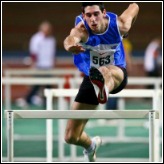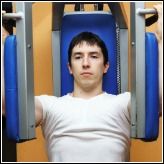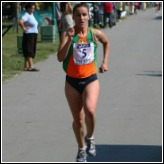Triple Jump Like A Champion
The modern triple jump technique has not always been the hop, step and jump. It is believed that the jump event of the ancient Olympics must have been a multi jump event, since the record was set at 16.76m, but it was probably a different combination of the three jumps we know today. In those early days of the event any combinations of three jumps were used. The combination of two hops and a jump is widely accepted as probably the dominant technique used by athletes until the early twentieth century.
The best triple jumpers are usually some of the most versatile power athletes in track and field today and they will all have the following qualities:
- They will be fast sprinters;
- Have great ballistic (jumping) qualities;
- They will have good rhythm, balance and fantastic agility to enable them to master the technique.
Phases of The triple Jump
The Run up
The start should be from standing - for accuracy.
The run should accelerate progressively until the last two strides.
The last two strides into take-off are made with a galloping (daa-de) rhythm.
The Hop (The same foot must be used to take off and land)
From the run the jumper executes a take-off by driving the alternate knee vigorously upwards along with the opposite arm. The athlete should feel a flat footed contact with the take-off board, although in actual fact it will be slightly heel first. The take-off leg is then extended explosively. Research of techniques of elite level jumping tells us that the best triple jumpers take off at an angle of 15 degrees-18 degrees.
During the flight of the hop, the knee of the take-off leg is picked up and brought to the front of the body so that the thigh is parallel to the ground. The athlete is then in a position to reach and actively land on the ground ready for the take-off of the second phase.
The Step (The landing must be made on the other foot from take-off)
The athlete can use a single or double arm action. The athlete must drive the free thigh vigorously so that once again it becomes parallel with the ground. The athlete often appears to demonstrate a splits position in the air when the action is completed properly. This position is held during the step phase flight. The athlete is again in a position to reach and actively land on the ground ready for the take-off of the third phase. The step take-off angle should be around 13 – 15 degrees.
The Jump
By the beginning of the jump phase, momentum of the jumper will have decreased significantly. For this reason a double arm shift should be used in the jump phase to help achieve additional thrust from the ground. The free knee should be driven hard and the take-off leg extended explosively. The jump phase, if long enough, can be completed with any of the recognised long jump techniques. However, beginners are unlikely to have enough time in the air for such luxuries, and a ‘stride’ or ‘hang’ style will be adequate.
The aim of the flight in the jump phase of the triple jump is to adopt a position in the air that will allow for an effective landing. That is, with legs fully extended in front, and with the arms high above the head so that they can be swung downward and backwards prior to the landing in the sand pit. This action lifts the feet just prior to landing. Take-off angle for the jump phase should be higher than in hop and the step phases – between 20 degrees and 24 degrees.
The Rhythm
of the Three Phases
The rhythm of the triple jump is vitally important to gaining good distance. The athlete should attempt to make the flight time of each jump more or less equal. The athlete should therefore sense TAA – TAA – TAA timing. Due to a lack of strength, beginners often demonstrate a huge hop, a very short step, followed by a long jump! This should be discouraged.
Arm Actions
Jumpers are able to help their performances by swinging their arms forward at take-off. Arms can be swung together, this is called a double arm shift. Alternatively, they can be swung one forward and one backward as in a natural running action. This is called a single arm shift. At take-off this swing adds lift, or upward momentum, to the athlete and aids total jump distance.
Apply the techniques above and you too can triple jump like a champion.
Sign Up For The Latest Track And Field News And Improve Your Athletic Performance!
Learn more about Track and Field
From "Triple Jump Like A Champion" Back To "Faster, Stronger, Better –
Your Shortcut To Improved Athletic Performance"







